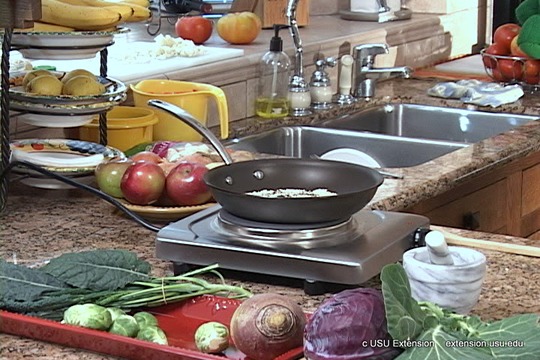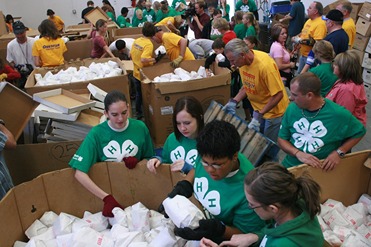Food Security – What It Is and Why It Matters

Introduction
When a household is food secure, it means food is consistently available, accessible, and used. However, in 2022, 13.5% of U.S. households (more than 44 million people) were food insecure at some point during the year (Rabbitt et al., 2023). Those who are food insecure cannot access sufficient food to meet their needs.
- Food and Agriculture Organization (FAO), 2006
Insufficient access to safe and nutritious foods can severely impact physical, mental, and social well-being. Without proper nutrition, focus levels, energy, and immune system support can decline, leading to long-term health challenges. Food insecurity increases the likelihood of malnutrition, chronic conditions, and social stigma, affecting individuals' overall quality of life (Meisenheimer, 2016; Feeding America, 2024).
Children are particularly vulnerable to the effects of food insecurity. In 2022, 17.3% of households with children were food insecure (Rabbit et al., 2023). This is especially concerning as quality nutrition is crucial for brain development and learning during infancy and early childhood (Meisenheimer, 2016). The impact of food insecurity on children can be both long-term and temporary, influenced by broader legal, political, economic, and social factors (FAO, 2006).
There are four main dimensions that make up food security (also known as pillars of food security): availability, accessibility, utilization, and stability. Each dimension must be intact to achieve consistent dietary variety to individuals and communities. Each pillar has a unique definition and factors that affect the pillars’ strength.
Pillars of Food Security
1. Food Availability

Food availability means a food supply consistently available for households to purchase and obtain. Food availability is determined by production rates, stock levels, and net trade (Global Food Security Cluster, 2023). Natural disasters, economic collapse, and conflict can cause intensified pressures, resulting in a lack of food security (FAO, 2006).
2. Food Accessibility
When food is accessible, households can regularly acquire adequate amounts of appropriate and desired food for a nutritious diet (Global Food Security Cluster, 2023). Food accessibility depends on how feasible it is to access the marketplace and have sufficient funds to purchase nourishing foods regularly. For this reason, poverty and low incomes are strongly associated with food insecurity (Feeding America, 2024). Those struggling with long-term health issues can also have complications as it becomes difficult to pay for medical bills and sufficient food (Feeding America, 2024). Location also impacts food accessibility as “areas which lack access to affordable, healthy foods” are known as food deserts, and those overwhelmed with unhealthy and calorie-dense foods are called food swamps (National Institute on Minority Health and Health Disparities [NIMHD], 2023).
3. Food Utilization
An adequate diet must be established by utilizing food, clean water, sanitation, and health care to reach a state of nutritional well-being (FAO, 2006). Education is pivotal to providing insights into safe food preparation, storage, and processing (Global Food Security Cluster, 2023). Food and water must be uncontaminated and clean, with diverse food choices to provide nutritious diets—crucial for the elderly, lactating women, and those with illnesses (Global Food Security Cluster, 2023; Peng & Berry, 2019).
4. Food Stability
This includes the consistent and reliable maintenance of the other three pillars of food security—availability, access, and utilization. Stability can be disrupted by natural disasters, wars, economic crises, or political instability, all of which can negatively affect food availability and overall food security (Peng & Berry, 2019). However, even in the face of sudden shocks or recurring challenges, a resilient food system should ensure that household food security remains intact and uncompromised (Global Food Security Cluster, 2023; FAO, 2006).
Food Insecurity and Its Relationship to Health Consequences
Those who face food insecurity are more prone to experience negative health consequences, such as heart disease, diabetes, and obesity (Feeding America, 2024; NIMHD, 2023). Other health implications like reduced mental health with increased anxiety and depression, lower energy, and difficulty focusing can also develop (Feeding America, 2024). These all affect daily life and can lead to a reduced immune system, and for children, a worsened school experience paired with possible delayed human development (NIMHD, 2023).
Food Security in Utah
Of Utah residents, 12.3% are food insecure—more than 400,000 people (Feeding America, n.d.-b). Though resources are in place, some counties experience higher rates of food insecurity than others. In Utah, San Juan and Piute counties have the highest rate of food insecurity at 19.8% and 19.2%, respectively. Morgan County has the lowest level of food insecurity at 8.2% (Feeding America, n.d.-b).
Resources Available if You Experience Food Insecurity
Many resources are available for those who are food insecure, including federal programs and 198 food banks in the United States (Feeding America, n.d.-a). The Utah Food Bank distributes goods to 245 emergency food pantries and partner agencies statewide (Utah Food Bank [UFB], n.d.-a). To offer additional help, available federal programs are listed in Table 1.
Table 1. Federal Programs Addressing Food Insecurity
|
Program name |
Program description |
Target population and eligibility |
Organization |
Website for more information |
|
Enrollment Programs |
||||
|
The National School Breakfast Program (NSBP) |
The NSBP is a federally assisted meal program operating in schools offering nutritional breakfasts at a free or reduced price, depending on eligibility (Food and Nutrition Service [FNS], 2024). |
Children whose families are at or below the federal poverty line of 130% receive free meals, and those with incomes between 130% and 185% qualify for reduced-price meals (FNS, 2024). |
United States Department of Agriculture and Utah State Board of Education |
|
|
The National School Lunch Program (NSLP) |
The NSLP operates similarly to the NSBP, offering nutritious free and reduced-price meals. |
Children whose families are at or below the federal poverty line of 130% receive free lunches, those with incomes between 130% and 185% qualify for reduced-price meals (Gupta & Johnson, 2023). |
Utah State Board of Education and local school or district offices |
Food Assistance Programs for Children, Utah State University (USU) Hunger Solutions Institute |
|
Kids Cafe |
Kids Cafe provides a free snack or evening meal to address the nutrition gap of children who “rely on free or reduced-price meal programs during the school day. (UFB, n.d.-c). |
Schools with 50% of their students eligible for free or reduced lunch can access meals |
Utah Food Bank |
|
|
The Summer Food Service Program (SFSP) |
The SFSP allows children to receive free meals throughout the summer at various locations, all sponsored by assorted organizations |
Anyone 18 and younger, specifically low-income children, can receive meals (USBE, n.d.-a). |
Utah Food Bank and U.S. Department of Agriculture |
|
|
Mobile School Pantries for Elementary School Children |
During the school year, a truck from the UFB makes monthly visits to elementary schools across Utah to provide students and their families with various food options |
Students from participating schools and their families can access pantries. |
Utah Food Bank and local school or district offices |
|
|
The Child and Adult Care Food Program (CACFP) |
This optional program provides nutritious food for those enrolled in participating care centers (USBE, n.d.-b). |
Children and disabled or older adults access food, with caregiver applications required (USBE, n.d.-b). |
Utah State Board of Education |
|
|
Meals on Wheels |
The Meals on Wheels program provides nutritious and ready-to-eat meals to seniors at a reduced or free cost (Meals, 2019). |
Adults aged 60 or older, or those with reduced mobility (Meals on Wheels America, 2019). |
Meals on Wheels America |
|
|
Recipient-Utilizing Programs |
||||
|
Women, Infants, and Children (WIC) |
WIC provides supplemental nutrition and breastfeeding services to low-income, pregnant, postpartum, and breastfeeding women. Children up to age 5 are also assisted. |
Utah residents with a specific gross income level based on household size and a “medical or nutrition-based" condition can |
Utah Department of Health and Human Services |
|
|
The Supplemental Nutrition Assistance Program (SNAP)b |
SNAP offers a supplemental money “allotment” each month to help households purchase various foods; funds are provided on an EBT card that can be used like a debit card (Department of Workforce Services [DWS], n.d.). |
Eligibility is based on net income; each state has various limits (DWS, n.d.). |
Department of Workforce Services |
|
|
Double Up Food Bucksb |
Those with SNAP benefits can “double up” at participating markets; purchasing twice as much produce as previously possible increases nutrient diversity (Double Up Food Bucks, n.d.). |
Eligibility is based on net income; each state has various limits (DWS, n.d.). |
Fair Food Network |
|
|
Create Better Health |
Create Better Health is Utah’s SNAP-Education program designed to make healthy eating more approachable for community members (Create Better Health, n.d.). |
This program is for anyone looking to increase their knowledge, especially those who want SNAP benefits to go further. |
Department of Workforce Services and USU Extension |
|
|
Commodity Supplemental Food Program (CSFP) |
The CSFP provides packages for pickup that contain 10 days’ worth of food and recipes to help optimize ingredients (UFB n.d.-b). |
Utah residents aged 60 or older with an annual income at or below 130% of the federal poverty guidelines (UFB, n.d.-b). |
Utah Food Bank |
Food Assistance Programs for Seniors (60+), Hunger Solutions Institute, USU |
|
Senior Farmers Market Nutrition Program (SFMNP) |
The SFMNP provides participants with a booklet of ten vouchers that can be redeemed for $5 each at participating farmers markets across Utah (Miguel, 2022). |
CSFP participants can receive vouchers. |
Utah Department of Health and Human Services |
Food Assistance Programs for Seniors (60+), Hunger Solutions Institute, USU |
|
Expanded Food and Nutrition Education Program (EFNEP) |
The EFNEP delivers nutrition lessons in a hands-on format to adults and youth to encourage the “improvement of the total family diet and nutritional well-being" (Expanded Food and Nutrition Program, n.d.). |
This program benefits adults and youth looking to enhance their nutrition intake and education. |
Utah EFNEP |
|
|
National Resources |
||||
|
Food banks |
A food bank is a warehouse that stores food gathered by donation efforts; food pantries supply goods from these banks to people in need (Feeding America, n.d.-a). |
Community members in need participate; some pantries have residency-based access (Feeding America, n.d.-a). |
Feed UT and Utah Food Bank |
|
|
211 |
Call 211 to “find agencies and community organizations that can assist you with finding food in an emergency” |
Anyone in need is eligible, especially those uncertain about where to start for help. |
United Way |
|
|
National Hunger Hotline |
This hotline is a resource to provide “immediate food assistance from government and private organizations to find food in any area” |
Anyone in need is eligible, especially those uncertain about where to start for help. |
USDA Food and Nutrition Services |
1-866-3-HUNGRY or 1-877-8-HAMBRE |
aNutritional risk is assessed “free of charge and will be completed at your first WIC appointment” (Utah WIC, n.d.).
bSNAP-eligible participants are also eligible for Double Up Food Bucks.

Ways to Support Food Security Efforts
There are many ways to help mitigate the effects food insecurity has on others. Many solutions include contacting a local food bank or pantry to ask how to help. Find and call an accessible location at Find Free Food and Groceries from Feeding America’s website. Donations are crucial; nonperishable food, volunteers, and money are valuable assets for food banks. There are other unique opportunities to make a difference, displayed in Table 2.
Table 2. Opportunities to Make a Difference in Food Security
|
Opportunity |
Opportunity description |
Organization |
Website for more information |
|
Organize a food drive or fundraiser. |
Food drives can successfully collect nonperishable food items at a large scale, while raising awareness for food insecurity (UFB, n.d.-a). |
Utah Food Bank |
|
|
Glean the harvest. |
There are various programs that “harvest produce that would otherwise be wasted and feed people who can use it” (Christensen Office of Social Action and Sustainability, n.d.). |
USU Christensen Office of Social Action and Sustainability |
|
|
Connect your community to support. |
Participate in a community group that works together to alert community members of crises, opportunities, and events. |
Mutual Aid Hub or Facebook |
|
|
Volunteer for Meals on Wheels. |
Volunteers provide nutritious meals, companionship, and a safety check for adults over 60 years old |
Meals on Wheels America |
|
|
Donate food, time, or money. |
Food banks can make the most out of all donations; UFB distributed 50.1 million meals through community support |
Utah Food Bank |
References
Christensen Office of Social Action and Sustainability. (n.d.) USU harvest rescue. Center for Community Engagement, Utah State University. Retrieved July 3, 2024, from https://www.usu.edu/social-action-sustainability/get-involved/cache-gleaning
Create Better Health. (n.d.). What we offer. Utah State University (USU) Extension. https://extension.usu.edu/createbetterhealth/
Department of Workforce Services (DWS). (n.d.). Basic information for SNAP (food stamps) applicants. Utah.gov. https://jobs.utah.gov/customereducation/services/foodstamps/index.html
Double Up Food Bucks. (n.d.). Get twice the fruits and veggies with double up food bucks. Fair Food Network. https://doubleupamerica.org/
Expanded Food and Nutrition Education Program. (n.d.). EFNEP.USU Extension. https://extension.usu.edu/weber/home-family-food/efnep
Feeding America. (2024). What is food insecurity? Retrieved June 7, 2024, from https://www.feedingamerica.org/hunger-in-america/food-insecurity
Feeding America.(n.d-a). Find your local food bank. Retrieved July 3, 2024, from https://www.feedingamerica.org/find-your-local-foodbank
Feeding America. (n.d-b). Food insecurity among the overall population in the United States. Retrieved June 25, 2024, from https://map.feedingamerica.org/county/2022/overall/
Food and Agriculture Organization (FAO).(2006, June). Food security [Policy brief]. https://www.fao.org/fileadmin/templates /faoitaly/documents/pdf/pdf_Food_Security_Cocept_Note.pdf
Food and Nutrition Service (FNS). (June 11, 2024). School breakfast program FAQs. U.S. Department of Agriculture. https://www.fns.usda.gov/sbp/faqs
Global Food Security Cluster. (2023, December 15). 2.3.1 The four pillars of food security. Food Security Cluster Handbook. https://handbook.fscluster.org/docs/231-the-four-pillars-of-food-security
Gupta, P., & Johnson, C. (2023). Food assistance programs for children [Fact sheet]. Utah State University Extension.
Meals on Wheels America. (2019). Find a meals on wheels provider near you. https://www.mealsonwheelsamerica.org/find-meals
Meisenheimer, M. (2016). Food insecurity in early childhood. Center of the Study of Social Policy. https://cssp.org/wp-content/uploads/2018/08/Food-Insecurity-Early-Childhood.pdf
National Institute on Minority Health and Health Disparities (NIMHD). (2023, April 26). Food accessibility, insecurity, and health outcomes. National Institutes of Health, U.S. Department of Health and Human Services. https://www.nimhd.nih.gov/resources/understanding-health-disparities/food-accessibility-insecurity-and-health-outcomes.html
Peng, W., & Berry, E. M., (2019). The concept of food security. Encyclopedia of Food Security and Sustainability, 2, 1–7. https://doi.org/10.1016/b978-0-08-100596-5.22314-7
Rabbitt, M. P., Hales, L. J., Burke, M. P., & Coleman-Jensen, A. (2023). Household food security in the United States in 2022 (Report No. ERR-325). Economic Research Service, U.S. Department of Agriculture. https://doi.org/10.32747/2023.8134351.ers
Utahns Against Hunger (n.d). Senior farmer’s market nutrition program. https://www.uah.org/get-help/senior-farmer-s-market-program
Utah Food Bank (UFB). (n.d.-a). Collection and distribution. https://www.utahfoodbank.org/about/collection-and-distribution/
UFB. (n.d.-b). Commodity supplemental food program (CSFP). https://www.utahfoodbank.org/csfp/
UFB. (n.d.-c). Kids café. https://www.utahfoodbank.org/programs/kids-cafe/
UFB. (n.d.-d). Mobile school pantry. https://www.utahfoodbank.org/programs/mobile-school-pantries/
Utah State Board of Education (USBE). (n.d.-a). Summer food service program (SFSP). https://schools.utah.gov/cnp/communityprograms/sfsp.
USBE. (n.d.-b). Child and adult care food program (CACFP). https://schools.utah.gov/cnp/communityprograms/cacfp
Utah Women, Infants & Children (WIC). (n.d.). About WIC. https://wic.utah.gov/about/
USAGov. (2023, December 7). How to get emergency food assistance. U.S. General Services Administration. https://www.usa.gov/emergency-food-assistance
September 2024
Utah State University Extension
Peer-reviewed fact sheet
Authors
MaKell Corry, Palak Gupta
Related Research


